Idukki Dam
The Idukki Dam is a double curvature Arch dam constructed across the Periyar River in a narrow gorge between two granite hills locally known as Kuravan and Kurathi in Kerala, India. At 168.91 metres (554.2 ft),[1] it is one of the highest arch dams in Asia. It is constructed and owned by the Kerala State Electricity Board. It supports a 780 MW hydroelectric power station in Moolamattom, which started generating power on 4 October 1975.[2] The dam type is a concrete, double curvature parabolic, thin arc dam.[3]
| Idukki dam | |
|---|---|
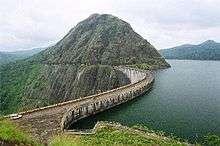 | |
 Location of Idukki dam in India  Idukki Dam (Kerala) 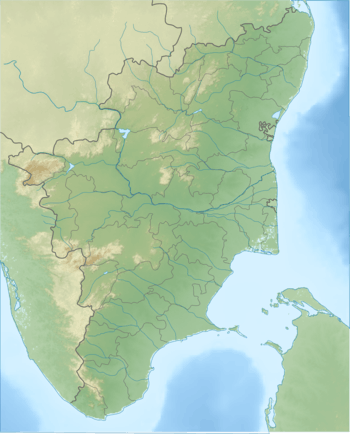 Idukki Dam (Tamil Nadu) | |
| Location | Idukki taluk , Kerala, India |
| Coordinates | 9°50′34″N 76°58′34″E |
| Purpose | Power generation |
| Status | Operational |
| Construction began | 30 April 1969 |
| Opening date | February 1973 |
| Owner(s) | Kerala State Electricity Board |
| Dam and spillways | |
| Type of dam | Concrete, double curvature parabolic, thin arch. |
| Impounds | Periyar River |
| Height | 168.91 m (554 ft) |
| Length | 365.85 m (1,200 ft) |
| Dam volume | 450,000 m3 (16,000,000 cu ft) |
| Spillways | Nil |
| Reservoir | |
| Total capacity | 5.55 km³ |
| Active capacity | 1,460×106 m3 (1,183,641 acre⋅ft) |
| Inactive capacity | 536×106 m3 (434,542 acre⋅ft) |
| Catchment area | 649.3 km2 (251 sq mi) |
| Surface area | 60 km2 (23 sq mi) |
| Normal elevation | 732.62 m (2,404 ft) |
| Power Station | |
| Commission date | 1975 |
| Turbines | 6 x 130 MW Pelton-type |
| Installed capacity | 780 MW |
This dam was constructed along with two other dams at Cheruthoni and Kulamavu. Together, the three dams have created an artificial lake that is 60 km2 (23 sq mi) in area. The stored water is used to produce electricity at the Moolamattom Power house, which is located inside nearby rocky caves. The Government of Canada aided in the building of the dam with long-term loans and grants.[2]
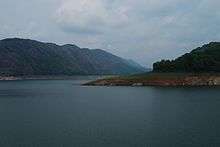
History
Early surveys
The idea of constructing a dam for power generation was first conceived in 1919 in a report submitted by Italian engineer Jacob to the Travancore government, which was rejected. As per history, Shri Chemban Karuvellayan Kolumban,[4] the head of 'Oorali' race during 1922, showed the way to the Malankara Estate Superintendent W.J.John and his friend AC Thomas Edattu, who were on hunting trip to forests near the present Arch Dam. Upon hearing the legend of Kuravan and Kurathi Hills, Thomas impressed by the sight of water flow between the mountains; suggested the spot suitable for an Arch dam. In 1932, W.J.John submitted a report to the Government of Travancore on the possibility of constructing a dam at Idukki for Power Generation.[5]
In 1935, assembly member Shri.K.A.Narayana Pillai brought the Idukki project to the attention of Government of Travancore. Italian engineers Angelo Omedayo and Clantheyo Masele conducted a study in 1937 but things didn't go forward.
In 1947, a preliminary investigation report was prepared and submitted by Sri. P. Joseph John, the then Chief Electrical Engineer to the Government of Travancore. It was during 1956 that the Central Water Commission conducted a detailed investigation based on the Government's request. The project report was prepared in 1961 and the Planning Commission accorded sanction for implementing the scheme in 1963. In 1964, under the leadership of Sri. E.U.Philipose, Superintending Engineer, preliminary works of the project were started.
Construction
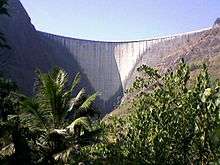
The construction of this Dam commenced on 30 April 1969. The project lead by Dr.D.Babu Paul IAS, who appointed as Project Coordinator, Idukki Hydel Project & District Collector with several engineers like Sri. C.V Mathews(Retired Chief Engineer, Electricity Board) . The Government of Canada aided the Project with long-term loans and grants. SNC-Lavalin, Canada, a well-known firm of Consulting Engineers were advising and assisting Project Engineers under Canadian aid, while Hindustan Construction Company (a.k.a. HCC) of Walchand group won the bid for construction.[6][7]
Storage of water in Idukki reservoir commenced in February, 1973. The inauguration of trial run of the first machine was celebrated on 4 October 1975. Commercial operation of the Power Station was Commissioned on 12 February 1976 by the then Hon. Prime Minister Smt. Indira Gandhi.
Features
Idukki Dam is 168.91 m (554.2 ft) tall, constructed between the two mountains - Kuravanmala (839 m (2,753 ft)) and Kuravathimala (925 m (3,035 ft)). Length of the dam on its top is 365.85 m (1,200.3 ft). It has a width of 7.62 m (25.0 ft) in the top and 19.81 m (65.0 ft) in the bottom. About 464,000 m3 (16,400,000 cu ft) of concrete was used in the construction of the dam. This project is situated in Idukki District and its underground power house is located at Moolamattom which is about 43 km (27 mi) from the dam. One thing to be noted is, Idukki Arch dam doesn't have any shutters to be opened so it has to rely on the Cheruthoni dam to maintain the reservoir water level.
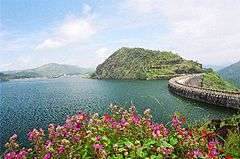
Usage
Power Generation
The Project harnesses a major portion of the power potential of Periyar, the largest river in Kerala, by the creation of a reservoir of 2,000 M.cum (2 Billion Tonnes) capacity, diversion of waters thus impounded through a water conductor system consisting of a power tunnel and two underground pressure shafts to an underground power house situated in Moolamattom. The installed capacity of the Power House is 780 MW consisting of 6 Units of Pelton-type turbines with a power generation capacity of 130 MW each. The regulated waters of Periyar falls through a drop of about 669.2 m (2,196 ft) while generating power in the underground power house. The generated power is given to two sub stations. One double circuit line to Kalamassery; one single circuit line to Tamil Nadu; One single circuit line to Pallom, 3 feeder bays for future.
Irrigation
The tail waters flowing to Kudayathurpuzha through tunnel and open channel is diverted for irrigation purposes in the Muvattupuzha Valley.
Tourist destination and attraction
Earlier, there was a blanket ban on public entry in to the dam due to security reasons. Later, it was relaxed opening the dam for public for 10 days during the Onam and the Christmas seasons. The duration has been increased to one month since last year. Cameras and cell phones are not allowed inside the dam area. The entry fee is Rs.25 for adults and Rs.5 for children. The fee for 15-minute boating service for five persons is Rs. 600.[8]
Idukki valley is 121 km (75 mi) away from Kottayam, and is a small hill town surrounded by a spread of beautiful, wooded valleys and meandering streams. Idukki is a well known tourist center in Kerala.
The Idukki Wildlife Sanctuary extends over the Thodupuzha and Udumbanchola taluks of Idukki district, spread over 77 km (48 mi) and is about 450–748 m (1,476–2,454 ft) above sea level. The Idukki Reservoir formed by three dams - Cheruthoni, Idukki and Kulamavu - extends to 33 km (21 mi). One can find elephants, bisons, sambar deer, wild dogs, jungle cats, tigers, wild boars etc. and a variety of snakes like cobra, viper, krait and a number of non-venomous snakes in this sanctuary. The birds of Idukki are Jungle fowl, myna, laughing thrush, black bulbul, peafowl, woodpecker, kingfisher, eagle etc.
References
- "Idukki Arch Dam". GOVERNMENT OF KERALA. Retrieved 20 August 2018.
- "Idukki District Hydroelectric projects". Retrieved 12 March 2007.
- "Salient Features – Dam". Retrieved 12 March 2007.
- https://www.thehindu.com/news/national/kerala/man-who-changed-the-course-of-a-river/article6721679.ece
- Idukki
- https://english.mathrubhumi.com/news/offbeat/idukki-dam-completes-42-years-today-power-1.2597167
- https://www.thenewsminute.com/article/building-idukki-dam-workers-hired-project-recall-struggle-85857
- Hindu, The. "Filled to its brim, Idukki dam woos tourists". The Hindu. Retrieved 21 September 2013.
Kendriya Vidyalaya, Idukki,Hill Station==External links==
| Wikimedia Commons has media related to Idukki Dam. |
- Idukki Dam at Structurae
- Idukki dam safe: Kadavoor
- Idukki Hydroelectric Project
- Old Photos
- https://idukki.gov.in/tourist-place/idukki-arch-dam/
Interesting Facts about Idukki dam